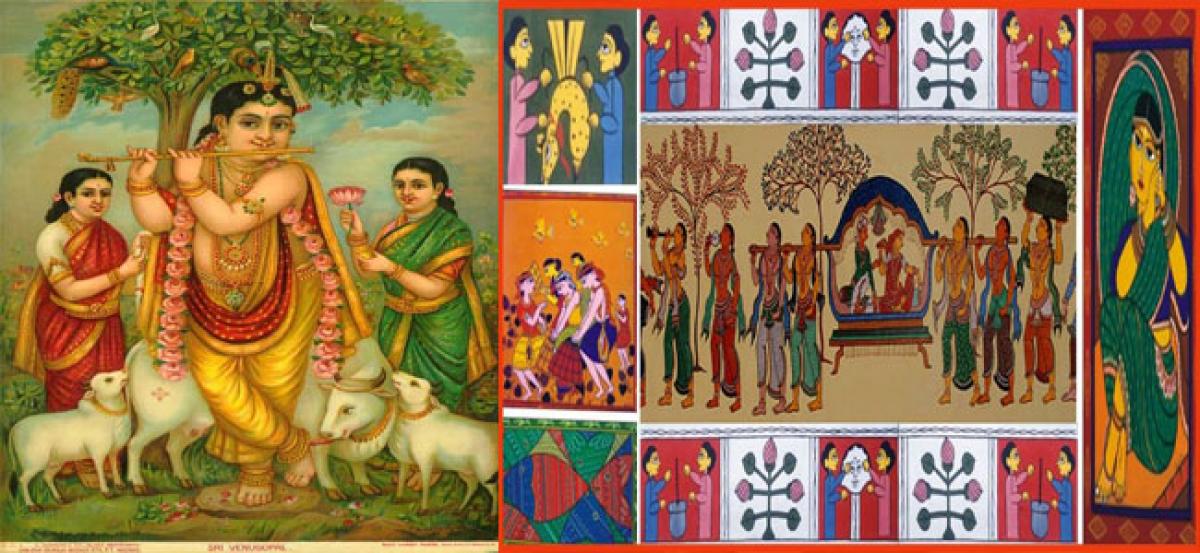Live
- Over 7,600 Syrians return from Turkiye in five days after Assad's downfall: minister
- Delhi BJP leaders stay overnight in 1,194 slum clusters
- Keerthy Suresh and Anthony Thattil Tie the Knot in a Christian Ceremony
- AAP, BJP making false promises to slum dwellers for votes: Delhi Congress
- 'Vere Level Office' Review: A Refreshing Take on Corporate Life with Humor and Heart
- Libya's oil company declares force majeure at key refinery following clashes
- Illegal Rohingyas: BJP seeks Assembly session to implement NRC in Delhi
- Philippines orders full evacuation amid possible volcanic re-eruption
- Government Prioritizes Welfare of the Poor, says Dola Sri Bala Veeranjaneyaswamy
- Two Russian oil tankers with 29 on board damaged due to bad weather
Just In

A rare collection of oil paintings, lithographs and oleographs from the 19th century on display here brings alive for aficionados an era famously known as the Pre-Bengal School of art. New Delhi
New Delhi : A rare collection of oil paintings, lithographs and oleographs from the 19th century on display here brings alive for aficionados an era famously known as the Pre-Bengal School of art.
"Most of the time there is no mention of the artist and the period, but these paintings help to develop an idea of the nature of the work of the artists and the era of these paintings," Reena Lath, Director, Akar Prakar gallery, where the exhibition is on, told IANS.
"At that time, religious and mythological paintings were more popular. Besides the paintings, the litho prints and oleographs also reveal the trends of the Pre-Bengal School. There are also oleographs of Bamapada Bandyopadhyay, besides the litho prints of Calcutta Art Studio and Kansaripara Art Studio," she said.
Titled, "Swadeshi Art", the exhibition began on August 28 and will continue till October 15. In the 19th century, the Mughal era, famous for its art and architecture, was coming to an end, and the French and Portuguese had established their trading outposts. Like the Mughals, these traders used local artists to satisfy their aesthetic sense and in places like Chinsurah, Chandarnagar and Serampore, artists were commissioned for portrait paintings.
At the behest of their patrons, the artists would paint the lords and ladies of the household, their pets and the houses as well. During this time, many of the artists became familiar with the landscape paintings of their European counterparts.
For instance, Sheikh Mansoor Ali of Kareya (Birbhum, in what is now West Bengal), imitated the Europeans and the paintings came to be known as belonging to the Company School. Some of these paintings are called "Dutch Bengal" or "French Bengal" according to their antecedents.
Alhough the foreigners were pleased with the efforts of the local artists, their sense of perspective or figures left much to be desired.
To correct this, the Calcutta School of Art (CSA) was set up in 1854 and, from 1864, its administration was completely taken over by the government.
Henry Hoover Locke, an alumnus of the Department of Science and Art of London's South Kensington School, was sent by the British government as the CSA's Director. He introduced the teaching methodology of his alma mater, which followed the Naturalism style of Joshua Reynolds.
"The products of this school brought a radical change in Calcutta's art scenario from the mid-19th century and these works constitute the Pre-Bengal School. These artists also strengthened the base of the Bengal School to come.
Both the British rulers and art connoisseurs of the time began to acknowledge that the artists of this school could form a platform for 'High Art'," curator Ashit Paul explained.
Patachitra (scroll) painting of Kalighat became popular at that time in Calcutta. Everything was depicted through this medium, which used cloth as a base. Mythology, religion, social scandals and social satire -- nothing was beyond the reach of the artists.
The popularity of this form inspired the woodcut artists of Hoogly's Battala neighbourhood. They also appeared in the market with huge, hand-painted, woodcut paintings. Not only this, the artists also painted for books and magazines -- and captured the market. They took the help of litho prints to stay in the competition. The outlines of the pictures would be printed and the artists would only fill in the colours.
Formal art-educated artists of that time were Annadaprasad Bagchi (1849-1905), Shyamacharan Shrimani, Nabakumar Bishwas (1861-1935), Phanibhushan Sen, Krishnachandra Pal, Yogendranath Mukhopadhyay, Bamapada Bandyopadhyay (1851-1932), Shashikumar Hem and Bhabanicharan Laha (1880-1946), to name just a few.
These artists would depict perspectives, figures and landscapes in oil and watercolours following the European method. Many portraits, religious paintings and other paintings were also created by them for Company officers or Indian patrons. These works were placed beside the European paintings in exhibitions and competitions and were appreciated by art connoisseurs locally as well as from other parts of the country.
By Saket Suman

© 2024 Hyderabad Media House Limited/The Hans India. All rights reserved. Powered by hocalwire.com







